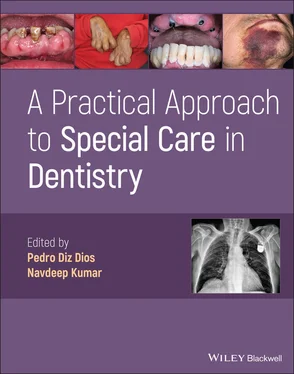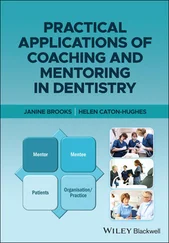A Practical Approach to Special Care in Dentistry
Здесь есть возможность читать онлайн «A Practical Approach to Special Care in Dentistry» — ознакомительный отрывок электронной книги совершенно бесплатно, а после прочтения отрывка купить полную версию. В некоторых случаях можно слушать аудио, скачать через торрент в формате fb2 и присутствует краткое содержание. Жанр: unrecognised, на английском языке. Описание произведения, (предисловие) а так же отзывы посетителей доступны на портале библиотеки ЛибКат.
- Название:A Practical Approach to Special Care in Dentistry
- Автор:
- Жанр:
- Год:неизвестен
- ISBN:нет данных
- Рейтинг книги:3 / 5. Голосов: 1
-
Избранное:Добавить в избранное
- Отзывы:
-
Ваша оценка:
- 60
- 1
- 2
- 3
- 4
- 5
A Practical Approach to Special Care in Dentistry: краткое содержание, описание и аннотация
Предлагаем к чтению аннотацию, описание, краткое содержание или предисловие (зависит от того, что написал сам автор книги «A Practical Approach to Special Care in Dentistry»). Если вы не нашли необходимую информацию о книге — напишите в комментариях, мы постараемся отыскать её.
Learn to treat dental patients with disabilities or who are medically compromised A Practical Approach to Special Care in Dentistry
A Practical Approach to Special Care in Dentistry
A Practical Approach to Special Care in Dentistry — читать онлайн ознакомительный отрывок
Ниже представлен текст книги, разбитый по страницам. Система сохранения места последней прочитанной страницы, позволяет с удобством читать онлайн бесплатно книгу «A Practical Approach to Special Care in Dentistry», без необходимости каждый раз заново искать на чём Вы остановились. Поставьте закладку, и сможете в любой момент перейти на страницу, на которой закончили чтение.
Интервал:
Закладка:
Generalised periodontal disease with numerous pathological periodontal pockets (≥6 mm)
Caries in #15, #34 and #46
Lost teeth: #27 and #36
Radiological Examination
Orthopantomogram undertaken
No intraoral radiographs due to large number of oral papilloma‐type lesions ( Figure 4.2.1)
Restorable caries in #34, #38 and #45
Extensive, deep and unrestorable caries in #15 and #46
Periapical osteolytic lesion in #46
Structured Learning
1 What is the cause of the oral lesions?The oral lesions are likely to be due to human papilloma virus (HPV) infection and are benign – oral papilloma/condyloma with focal epithelial hyperplasiaHIV and HPV are both infections that can be transmitted sexually Figure 4.2.1 Oral HPV‐associated papillomatosis in AIDS.Immunosuppression is known to increase the risk of HPV infectionHPV oral lesions in patients with HIV infection and taking antiretrovirals may be related with the longer life expectancy of individuals with an impaired immune system rather than a direct effect of antiretroviral therapy (ART)
2 The patient's primary concern is removal of the oral lesions as the teeth are asymptomatic. What additional information do you need first regarding his HIV infection?Current viral load: the results are given as the number of copies of HIV per millilitre of bloodCurrent CD4 count: normal CD4 count is from 500 to 1400 cells per microlitre of blood
3 The physician advises you that the last test results are: viral load 13 000 copies/mL and CD4 count of 100 cells/μL. What factors are important to consider when assessing the risk of managing this patient?SocialPhysical stigma in a work setting that is probably unaware of his HIV infection (i.e. oral warts)Risk of patient not attending appointments due to low mood/depression (see Chapter 15.2)MedicalHIV infection in the acquired immune deficiency syndrome (AIDS) stage – CD4 count low leading to an increased risk of infection; viral load high (increased infectivity)Ritonavir may cause thrombocytopeniaChronic HBV infection (see Chapter 4.3) linked to bleeding risk, reduced drug metabolismAnal carcinoma – may be uncomfortable for the patient to sit down if the lesion is symptomaticDentalOral lesions may impair access to toothbrushingOral hygiene not optimal – may increase the risk of postoperative infection after removal of the oral papillomasLesions may recur after removalDental caries and periodontal disease presentFollow‐up compromised by the depressive syndrome and previous irregular attendance
4 As the lesions are widespread and some are sessile, vaporisation of the papillomatous lesions using CO2 laser is planned. What precautions should be in place?Perform the necessary laboratory tests (e.g. complete blood count with differential and coagulation study)Administer antibiotic prophylaxis because the patient has <200 CD4+ T‐cells/μLTake a sample with a cold scalpel beforehand to conduct histopathologyMaximise protection measures with subsequent use of the CO2 laser to prevent dissemination of the papillomavirus:Powerful surgical aspiratorFacemasks and eye protectorsSchedule the appointment for the last hour of the workday and ventilate the dental office after completing the procedure
5 The patient is nervous about the proposed vaporisation of the oral lesions and has been prescribed diazepam to take before he attends. What considerations should be taken into account?Ritonavir can boost the sedative effects of benzodiazepinesIf the hepatic impairment caused by the HBV is moderate to severe, the use of diazepam should be avoided (liaise with the physician and preferably use lorazepam)
6 The patient returns to you for extraction of the #15 and #46. What laboratory test results should be undertaken before proceeding and why?Full blood count and coagulation study should be undertakenAnaemia, thrombocytopenia and leucopenia/neutropenia may be presentThrombocytopenia can occur in people with HIV due to multiple factors, including HIV infiltration of the bone marrow, as a side‐effect of drugs used to treat HIV (e.g. ritonavir), or due to the development of autoimmune (idiopathic) thrombocytopenic purpuraNeutropenia is observed in 10% of patients with early asymptomatic HIV infections and in 50% of patients with AIDS (again related to bone marrow infiltration and as a side‐effect of some medications)HBV infection can impair the hepatic synthesis of coagulation factors
General Dental Considerations
Oral Findings
Oral lesions in patients with HIV infection are mainly related to the state of immunosuppression and the adverse effects of the antiretroviral drugs ( Tables 4.2.1and 4.2.2; Figures 4.2.2and 4.2.3)
Table 4.2.1 Potential consequences of HIV disease.
| Category | Associated conditions |
|---|---|
| GROUP 1 Lesions closely associated with HIV infection | CandidiasisHairy leucoplakiaKaposi sarcomaNon‐Hodgkin lymphomaPeriodontal diseaseLinear gingival erythemaNecrotising gingivitisNecrotising periodontitis |
| GROUP 2 Lesions less commonly associated with HIV infection | Bacterial infections: Mycobacterium avium‐intracellulare , M. tuberculosis Melanin hyperpigmentationNecrotising stomatitisSalivary gland enlargementThrombocytopenic purpuraUlcer not otherwise specified (NOS)Viral infections: Herpex simplex, Papillomavirus, Varicela‐zoster virus |
| GROUP 3 Lesions reported in HIV infection | Bacterial infections: Actinomyces israelii , Escherichia coli , Klebsiella pneumoniae , Cat scratch disease ( Bartonella henselae )Viral infections: Cytomegalovirus, Molluscum contagiosum Drug reactionsFungal infections other than candidiasisNeurological disorders |
Dental Management
The dental treatment plan will be determined mainly by the patient's general condition, prognosis and prior oral health ( Figure 4.2.4)
Each procedure should take into account the patient's immunosuppression level, potential complications (e.g. tendency to bleed) and presence of comorbidities (e.g. chronic viral hepatitis) ( Table 4.2.3)
Section II: Background Information and Guidelines
Definition
The HIV is a retrovirus of the lentivirus group. When transmitted to a patient, HIV mainly targets T helper cells (CD4+ cells), which are essential for the immune response. The initial infection is followed by a long period of gradual deterioration of the immune system, which leads to the AIDS phase. It is estimated that more than 37 million individuals worldwide have HIV/AIDS and that its current rate is 1.7 million new cases per year.
Aetiopathogenesis
At this time, the main groups exposed to HIV infection are men who have sex with men, individuals who engage in risky heterosexual contact and parenteral drug users (the risk of perinatal transmission has declined dramatically in recent years)
Two types of HIV, which share the same mechanism of action, have been identified: HIV‐1, which has a worldwide distribution, and HIV‐2, which is more common among African populations
HIV infects cells with CD4+ receptors, mainly T‐cells, monocytes, tissue macrophages and dendritic cells. Within the cell, HIV replicates using the reverse transcriptase enzyme. The resulting DNA is imported into the cell nucleus and integrated. The infected cells release new virus particles by gemmation and the cells are ultimately destroyed
Clinical Presentation (CDC Classification)
Stage 1: Initial infectionCan be asymptomaticWithin 2–4 weeks after infection, may also present as viral symptoms similar to influenza (fever, headache, lymphadenopathy, myalgia and exanthema)High viral load and infectivity Table 4.2.2 Main antiretroviral drugs with adverse orofacial effects.Drug class Generic nameAdverse orofacial effectsErythema multif.UlcersDry mouthDysgeusiaExfoliative cheilitisMucosal pigm.Cushingoid appear.Lipodys.Nucleoside/nucleotide reverse transcriptase inhibitors Zidovudine (AZT)Didanosine (DDI)Zalcitabine (ddC)Stavudine (d4T)Lamivudine (3TC)Abacavir (ABC)Adefovir (ADF)Tenofovir (TDF)Emtricitabine (FTC)+ + + + + + + + + + + + + + + + + Non‐nucleoside reverse transcriptase inhibitors Etravirine (ETR)Delavirdine (DLV)Efavirenz (EFV)Nevirapine (NVP)+ + + + + + + + + + + + Protease inhibitors Saquinavir (SQV)Ritonavir (RTV)Indinavir (IDV)Nelfinavir (NFV)Amprenavir (APV)Tipranavir (TPV)Fosamprenavir (FPV)Atazanavir (ATV)Darunavir (DRV)+ + + + + + + + + + + + + + + + + + + + + + + + + + + + + + + + + Fusion inhibitors Enfuvirtide (ENF)+++Entry inhibitors Maraviroc (MVC)++Integrase strand transfer inhibitors Raltegravir (RAL)++Erythema multif., Erythema multiforme; Mucosal pigm., Mucosal pigmentation; Cushingoid appear., Cushingoid appearance; Lipodys., Lipodystrophy Figure 4.2.2 (a–c) Lesions closely associated with HIV infection: oral candidiasis, oral hairy leucoplakia and Kaposi sarcoma. Figure 4.2.3 Exfoliative cheilitis as an adverse oral effect of proteinase inhibitors. Figure 4.2.4 Infection control in the dental clinic. Table 4.2.3 Considerations for dental management.Risk assessmentThere are no absolute contraindications for performing dental treatment on patients with HIV infectionHowever, due to the HIV‐associated immunosuppression, it is important to consider any associated comorbidities (e.g. chronic hepatitis) and side‐effects of medication (e.g. thrombocytopenia related to ritonavir, neutropenia related to zidovudine)The transmission rate is estimated at 0.3% after exposure to contaminated blood by the percutaneous pathway and approximately 0.09% after contact with mucous membranesCriteria for referralMost patients can be treated in a conventional outpatient dental clinicReferral to a specialised clinic or hospital centre is determined mainly by the patient's general condition, presence of severe immunosuppression, presence of comorbidities and/or increased bleeding riskAccess/appointmentA number of barriers to treatment have been identified for these patients and include the anxiety caused by the dental setting, reluctance by the dentist to see them, concerns regarding confidentiality, cumbersome administrative processes, long waiting times and psychological problemsIf the viral load is high, schedule the patient for the last session of the day to minimise the risk of cross‐transmissionCommunicationA significant percentage of patients with HIV infection who receive dental treatment do not report their conditionAn HIV diagnostic test and/or the possibility of referring to the family doctor should be offered to patients with suspicious medical histories or oral findingsConsent/capacityPatients should be warned of the potential complications resulting from the HIV infection, side‐effects of medication and the additional risks associated with existing comorbiditiesNeurological involvement in HIV (HIV‐associated dementia) is commonly associated with cognitive impairment but is rare in those patients receiving antiretroviral drugs; comorbid conditions can also contribute to impairmentAnaesthesia/ sedationLocal anaesthesiaMinimise the risk of pricking with contaminated needles after infiltrative anaesthesia (e.g. single‐use devices)SedationMinimise the risk of pricking with contaminated needles after percutaneous injectionThe activity of benzodiazepines administered for sedation can increase in patients who take protease inhibitorsGeneral anaesthesiaA comprehensive assessment in conjunction with the anaesthetist is essentialThe patient's physician should be consulted and investigations undertaken to assess the risk of bleeding, infection and whether there are any concurrent infections which would compromise respirationDental treatmentBeforeUniversal cross‐infection control measures should be appliedThe treatment plan will be determined by the HIV disease prognosis and the previous oral health condition, among other factorsThe dental treatment needs of patients with HIV infection are significantly greater for those with a history of parenteral drug useRecent blood test results should be available including:CD4+ T‐lymphocyte countViral loadFull blood count (risk of anaemia, leucopenia, neutropenia, thrombocytopenia)Coagulation study (in case of liver disease)If invasive dental procedures are planned, it is advisable to administer antibiotic prophylaxis to patients with <200 CD4+ T‐cells/μL and/or those who with moderate neutropenia (500–1000 cells/μL)For cases of severe neutropenia (<500 cells/μL), antibiotic prophylaxis is mandatoryDuringApply conventional measures for infection controlIn the event of accidental exposure in the dental clinic, the contaminated area should be washed with soap and water, and the reference physician should be immediately informed so that they can evaluate the risk of exposure and the advisability of diagnostic tests and prophylactic administration of antiretroviral agentsAfterThe prevalence and severity of complications after an extraction are similar to those observed in healthy controlsThe success rates of osseointegrated implants, sinus lifts and bone regeneration surgery are similar for patients with well‐controlled HIV infection and the HIV‐negative populationBasic periodontal treatment procedures and periodontal surgery have been successfully performed in this contextThe rate of postoperative complications and the elimination of periapical lesions following a root canal are similar to those detected in the general populationDrug prescriptionThere is an increased risk of hypersensitivity to some drugs such as beta‐lactamsMetronidazole can cause a disulfiram‐like reaction in patients who take ritonavirThe risk of haematological toxicity and bleeding in patients who take zidovudine can increase if non‐steroidal anti‐inflammatory agents are administered concomitantlyEducation/preventionIf a patient is aware of their HIV‐positive condition and potential impact on the oral cavity, this can promote the need to maintain a healthy mouth and result in an improvement in their oral hygiene habitsPatients should be counselled regarding oral hygiene, xerostomia treatment, smoking cessation and reducing sugar in their dietMaintaining good oral health can prevent the onset of rapidly progressive periodontal diseaseEmphasis should be placed on cleaning the dental prosthesis and disinfecting toothbrushes (with antiseptic solutions such as chlorhexidine)Patients with peripheral neuropathy might have limited manual dexterity for performing proper oral hygiene
Читать дальшеИнтервал:
Закладка:
Похожие книги на «A Practical Approach to Special Care in Dentistry»
Представляем Вашему вниманию похожие книги на «A Practical Approach to Special Care in Dentistry» списком для выбора. Мы отобрали схожую по названию и смыслу литературу в надежде предоставить читателям больше вариантов отыскать новые, интересные, ещё непрочитанные произведения.
Обсуждение, отзывы о книге «A Practical Approach to Special Care in Dentistry» и просто собственные мнения читателей. Оставьте ваши комментарии, напишите, что Вы думаете о произведении, его смысле или главных героях. Укажите что конкретно понравилось, а что нет, и почему Вы так считаете.












